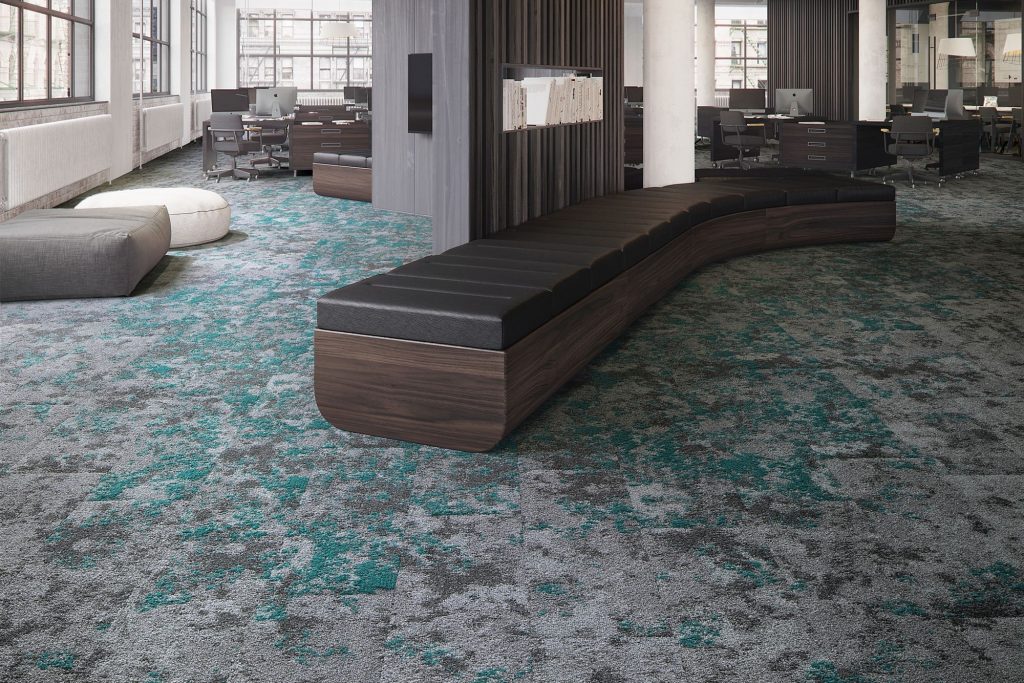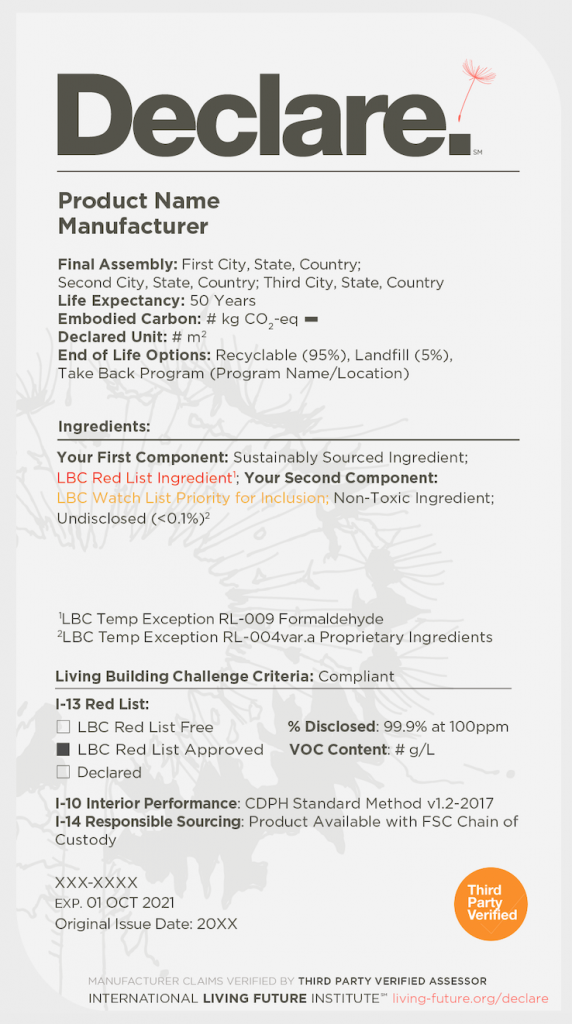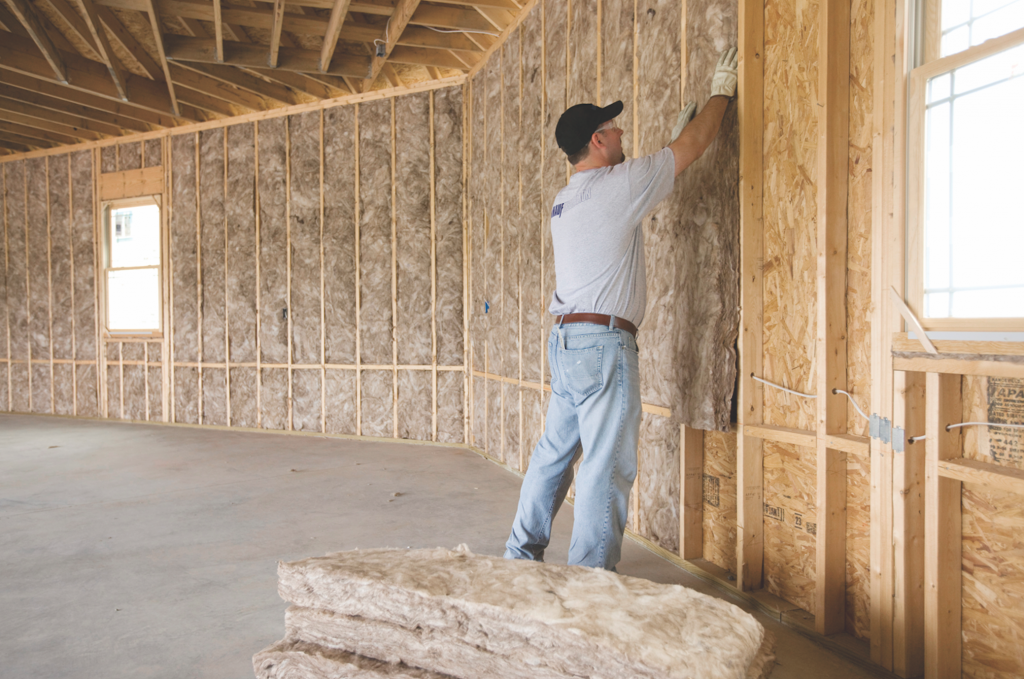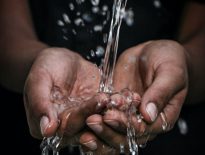Let’s get down to business: the economic case for Declare and the Living Product Challenge
Stop me if you’ve heard this one before: what’s the return on investment for going green?
Don’t worry, you’re not alone! We hear it all the time. Fortunately, the business case for going green has never been clearer and “going green” now means doing something that is good for the environment and for your wallet. This didn’t use to be the case, so what has changed? It’s a combination of forces coming together, including pressure from investors and shareholders, pressure from consumers, and a larger shift in ideology by younger generations who are wielding more power in the marketplace. There has never been a better time for a company to transform their practices to embrace sustainability than now, and companies who do will see the biggest benefits.
Let’s start with the money. In the past, one of the biggest stumbling blocks has been the perception that designing, manufacturing, and shipping sustainable products is more expensive than traditional methods of production. On top of that, this was coupled with a perception that investors and shareholders weren’t interested in investing in sustainable practices, especially since they were seen as more expensive. This is perhaps the most fundamental shift we see in the marketplace: that these perceptions are now actively being challenged and rebutted.
In his 2020 letter to investors, BlackRock CEO Larry Fink wrote that “with the impact of sustainability on investment returns increasing, we believe that sustainable investing is the strongest foundation for client portfolios going forward.” BlackRock is the world’s largest investment firm, managing over $7 trillion worth of assets. For their CEO to dedicate his entire annual letter to climate change represents a fundamental shift in the market. Not only that, but in January of 2021 he reiterated this message, this time with data to back it up. BlackRock found that during the first quarter of 2020, during the initial Coronavirus market dip, 94% of indexes with sustainable companies outperformed parent benchmark indexes (similar types of companies without explicit sustainability goals).

And it’s not just BlackRock: in their September 2020 Special Climate Report, The Economist stated bluntly “companies that fail to tackle climate change face a backlash.” Note the report does not say “will face a backlash,” but is in present tense. According to The Economist, the backlash against companies not directly addressing their contribution to climate change is happening now.
What accounts for this shift? It comes down to risk management. The Coronavirus has demonstrated that companies who do not have a handle on their supply chains and manufacturing processes will suffer financially during periods of instability. Just as the Coronavirus has disrupted supply chains, the effects of climate change such as significant weather events (hurricanes, wildfires, etc) will similarly disrupt supply chains at an increased pace if we don’t swiftly and properly address climate change. Manufacturers who do not have a complete understanding of their supply chains or have not adapted their supply chains to account for these events will become riskier financially in the face of climate change.
Not only will companies who do not address their contribution to climate change be vulnerable financially to supply chain instability, The Economist also predicts they will be vulnerable to expensive litigation. They report that there is increasing scientific evidence directly linking extreme weather patterns (the types that threaten current supply chains) to fossil fuel consumption and greenhouse-gas emissions. Companies who are found to be heavy polluters and carbon emitters will increasingly be targeted with litigation holding them accountable. The Economist goes so far as to say that “if cases follow the same route as those against Big Tobacco, the costs could be high.” Similar to Big Tobacco, if science has made the direct link between greenhouse-gas emissions and climate change, and large companies are found to be emitting large amounts of greenhouse gasses, there is a big chance they will be held financially liable.
Investors such as BlackRock have taken notice of these market trends and are now informing their shareholders that they will take the sustainability of a company into consideration before investing. Larry Fink went a step further in his 2020 letter, saying “in the absence of robust disclosures, investors, including BlackRock, will increasingly conclude companies are not adequately managing risk.” For these investors and shareholders, addressing climate change is now a good business practice because it reduces the potential for disruptions that will affect their bottom line. Sustainability disclosures have come into focus for two reasons, then: one is that they provide a framework for companies to evaluate their supply chains, and two, that they provide evidence they are taking sustainability seriously.
It’s not just investors taking this seriously, the number of consumers that make sustainability a priority is growing rapidly. NielsenIQ, the consumer intelligence firm, reports that sustainable products (such as organic products or products with natural ingredients) make up 22% of total sales, and between 2014 and 2017 sustainable product sales grew by 3% while the sales of conventional products dropped by 4% in that same time. NielsenIQ went so far as to call 2018 the “year of the sustainable consumer” which will soon turn into the “decade of the sustainable consumer.”

Driving this market shift are Millennials and GenZ. The NielsonIQ survey finds that 90% of Millennials are willing to pay more for products that are environmentally friendly or use sustainable ingredients, and 80% are willing to pay more for products that claim some kind of social sustainability practice. We can joke all we want about Millennials and avocado toast, but as The Economist points out, by 2035 they will have more wealth than baby boomers. By then they will be the leaders of architecture and design firms and their spending habits will undoubtedly be reflected as they specify products for their projects. What’s more, NielsonIQ finds that Millennials are much more willing than Baby Boomers to abandon a brand that has not made a commitment to sustainability and find a brand that has made a commitment (53% of Millennials vs. 34% of Boomers). Manufacturers will find it harder to rely on simple brand loyalty to get onto projects, and will instead need to directly address their customers’ preference for sustainable products. In his 2021 letter, Larry Fink states this explicitly: “companies ignore stakeholders at their peril – companies that do not earn this trust will find it harder and harder to attract customers and talent, especially as young people increasingly expect companies to reflect their values. The more your company can show its purpose in delivering value to its customers, its employees, and its communities, the better able you will be to compete and deliver long-term, durable products for shareholders.”
When it comes to working with companies that claim to be sustainable, investors and consumers are in alignment: they want proof. Gone are the days that consumers and investors will simply “take your word for it” and companies can issue vague statements and promises. Your clients and investors want transparency and they want data. That is where the International Living Future Institute comes in. Our two pioneering certifications, the Declare label and the Living Product Challenge, offer manufacturers a framework to disclose what is in your products and manufacturing process so consumers can prioritize working with the companies already walking the walk.
The Declare Label is like a nutrition label for products: it tells consumers the chemical ingredients that make up a product down to 100 parts per million. It also screens the chemicals in the product against the Red List. The Red List was developed by ILFI and includes worst in class chemicals – those that pollute the environment, those that stick around in the atmosphere and environment for a long time, and chemicals that are harmful to humans. The Red List is singular in that it addresses the toxicity of a chemical to folks who are around the production of a material as well as the end user. A product that has a Declare label that shows it to be Red List Free contains none of these chemicals – a remarkable accomplishment and the label gives manufacturers a way to prove to consumers they are taking sustainability seriously.
The Living Product Challenge builds on the Declare Label by creating a revolutionary framework for manufacturers to create restorative products. It fundamentally reimagines the way products are designed and manufactured, and gives consumers and investors the information they are asking for. In addition to disclosing the chemical ingredients (Living Products are required to be Red List Free!), it also discloses the impacts of the manufacturing process. With easy-to-read graphics, the label shows how much carbon, energy, and water was used to make a product as well as how much waste was generated during production. Unique to the Living Product Challenge is the concept of Handprinting. While investors and clients are asking to see data regarding your Footprint (how your manufacturing process contributes to climate change and emissions), consumers are also very interested in social justice initiatives your company is involved in.

The Living Product Challenge is the only certification that gives companies a way to report the measurable positive effects they are having on their communities. We call this Handprinting and they can be created anywhere and everywhere in our communities, the only requirement is that the Handprints be real and measurable and there are myriad ways to create them. Some Living Product manufacturers have invested in the energy retrofit of a school, installed rainwater catchment systems in a nearby community, or protected a key ecological habitat. There is no limit to the potential of businesses and their employees to create positive impacts, and such impacts can count as Handprints as long as they can be measured. This gives consumers the whole picture of your company: not just the negative impacts, but also the positive impacts you’re making in the world, which consumers care about just as much as the ingredients that make up your product.
When it comes to addressing the needs of your investors, shareholders, and consumers alike, ILFI has you covered. The Declare Label is the only certification on the market that combines material transparency with material health, and the Living Product Challenge is the only disclosure that combines material transparency, life cycle disclosure, and handprinting (social equity) in one label.
As companies start to address their contribution to climate change, the first step is to understand what your contribution is to begin with. Some companies don’t even know what chemical ingredients make up their products, or what their supply chain is like. The Declare Label helps you understand that and communicate it to your customers. When it comes to carbon emissions, The Economist reports that most companies don’t even know how much carbon their manufacturing process produces, making it impossible to know how to improve. The Living Product Challenge offers companies a way to perform an audit on all their emissions. It’s a twofer: not only does it help you understand your supply chain and emissions, you can use the label to provide the disclosure your investors and customers are asking for.
When it comes to addressing climate change, companies have a huge part to play. It seems overwhelming and while it will be incredibly challenging, there are equally large opportunities for enormous benefits, not just for the planet, but for your business. Investors and consumers are asking for disclosure and pushing for radical change, and will reward you handsomely if you take action now. The Economist said it best in their Special Climate Report: “De-carbonizing the economy holds many risks but it also offers plenty of opportunities. Firms that get ahead of their rivals will reap the biggest benefits.” Get started today with Declare and Living Product Challenge and start reaping those benefits!
Cover image: Humanscale products are Declare-labeled and certified under the Living Product Challenge. Image courtesy of Humanscale


